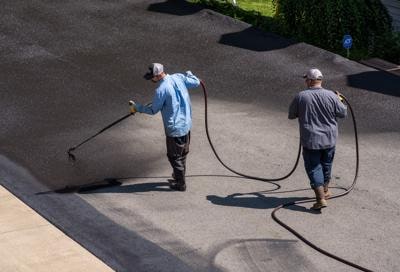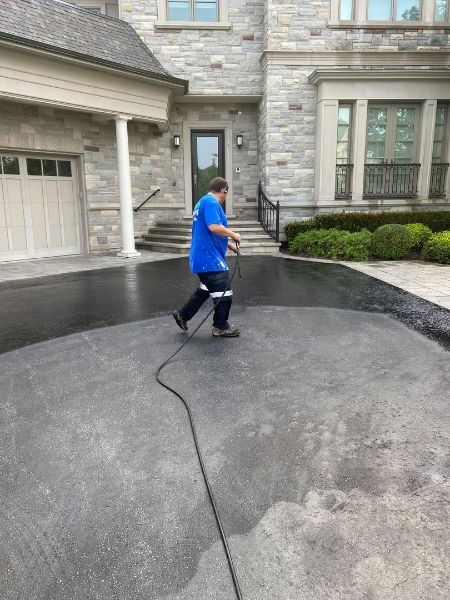Raise Security and Charm: Angled Parking Area Solutions with Asphalt Sealing
Raise Security and Charm: Angled Parking Area Solutions with Asphalt Sealing
Blog Article
Warm Mix Asphalt: A Sustainable Service for Sidewalk
Warm Mix Asphalt (HMA) has become a leading lasting option for sidewalk solutions, using a myriad of ingenious technologies and environmental benefits. Its ability to reuse materials and minimize energy intake provides a compelling case for its adoption in roadway construction tasks. The long-term efficiency and toughness of HMA make it a favored option for framework growth. As the demand for environment-friendly construction practices expands, discovering the nuances of HMA's sustainability can offer important understandings right into the future of pavement remedies.
Environmental Advantages of Hot Mix Asphalt

Moreover, Hot Mix Asphalt aids to reduce city warm island effects. Its dark shade soaks up sunlight, lowering the amount of warmth reflected back right into the atmosphere contrasted to lighter-colored pavements. This can reduce ambient temperatures in metropolitan locations, decreasing the demand for cooling and eventually lowering energy intake.
Furthermore, Warm Mix Asphalt adds to boosted stormwater monitoring. Its permeable nature enables water to recharge and penetrate the sidewalk groundwater products, reducing drainage and the danger of flooding. These environmental benefits make Warm Mix Asphalt a lasting selection for leading roadways and freeways.
Energy Efficiency in HMA Production
Is power performance a critical variable in the production of Hot Mix Asphalt (HMA)? Power plays a considerable function in the manufacturing of HMA, influencing both expense and environmental sustainability. One vital element of energy performance in HMA manufacturing is the use of cozy mix asphalt (WMA) innovations.
Moreover, advancements in plant innovations have actually led to more energy-efficient HMA production procedures. By maximizing energy use in HMA manufacturing, the industry can minimize its carbon impact while maintaining top notch sidewalk materials.
Recyclability of Hot Mix Asphalt
The recyclability of Warm Mix Asphalt (HMA) is a crucial aspect of its sustainability and long-lasting ecological impact. HMA is among one of the most recycled products in the USA, with over 100 million lots of recovered asphalt sidewalk (RAP) being reused yearly in brand-new sidewalk construction. Recycling HMA uses numerous environmental benefits, such as minimizing the need for virgin materials, reducing power consumption during manufacturing, and lowering the quantity of waste sent to garbage dumps.
The process of recycling HMA entails crushing the existing sidewalk, squashing it into smaller items, and mixing it with new accumulation and asphalt binder to develop a recycled mix. Generally, the recyclability of HMA plays a considerable role in advertising lasting practices within the sidewalk market.

Long-Term Efficiency of HMA
Asphalt sidewalks Recommended Site show durability and resilience over an extended period, reflecting the long-term performance of Hot Mix Asphalt (HMA) The longevity of HMA can be credited to its ability to withstand rush hour loads, harsh weather, and the effects of aging. Studies have actually revealed that properly designed and appropriately created HMA sidewalks can last for two decades or even more with routine maintenance. The secret to making best use of the lasting efficiency of HMA lies in utilizing top notch products, adhering to ideal techniques in building, and applying reliable upkeep methods. Appropriate water drainage, routine assessments, and prompt fixings are crucial for maintaining the structural integrity of HMA sidewalks gradually. Additionally, innovations in have a peek at this website HMA modern technology, such as making use of polymer-modified binders and warm mix asphalt, have actually additionally enhanced the longevity and long life of HMA pavements. By focusing on high quality construction and maintenance techniques, HMA remains to prove itself as a cost-effective and lasting solution for resilient pavement framework.

HMA: Durability and Sustainability
Demonstrating both longevity and sustainability, Warm Mix Asphalt (HMA) has actually ended up being a foundation in the building and construction of resilient pavement infrastructures - commercial parking lot paving. HMA's resilience stems from its capacity to stand up to heavy lots, severe weather, and high traffic quantities, making it a reputable selection for streets, highways, and airport terminal runways. The composition of HMA, which commonly includes accumulations, binder, and filler, plays a crucial function in improving its durability and resistance to tear and put on
In addition, HMA's sustainability exists in its recyclability and energy-efficient manufacturing process. The capability to reuse recovered asphalt sidewalk (RAP) in new HMA blends minimizes the need for virgin products and decreases the ecological influence of pavement building and upkeep. In addition, the energy efficiency of creating HMA hinges on its reduced mixing temperatures contrasted to various other sidewalk products, leading to decreased energy usage and greenhouse gas exhausts.
Verdict
To conclude, warm mix asphalt (HMA) offers a sustainable service for pavement with its eco-friendly attributes. HMA's recyclability, power performance in manufacturing, and lasting sturdiness make it an environmentally friendly option for road building. By saving all-natural sources, minimizing waste, and decreasing greenhouse gas exhausts, HMA plays a critical function in promoting sustainability in infrastructure development. Its capacity to mitigate urban heat island effects further underscores its relevance in developing resistant and eco mindful pavement systems.
HMA is one of the most recycled materials in the United States, with over 100 million bunches of redeemed asphalt sidewalk (RAP) being reused yearly in brand-new sidewalk construction.The process of reusing HMA entails grating the existing pavement, squashing it right into smaller sized pieces, and blending it with brand-new accumulation and asphalt binder to create a recycled mix.Asphalt sidewalks demonstrate durability and strength over a prolonged duration, reflecting the lasting performance of Warm Mix Asphalt (HMA) Additionally, improvements in HMA technology, such as the usage of polymer-modified binders and cozy mix asphalt, have better enhanced the toughness and longevity of HMA pavements. The capacity to reuse recovered asphalt sidewalk (RAP) in brand-new HMA combinations decreases the need for virgin materials and reduces have a peek here the ecological impact of pavement building and construction and maintenance.
Report this page